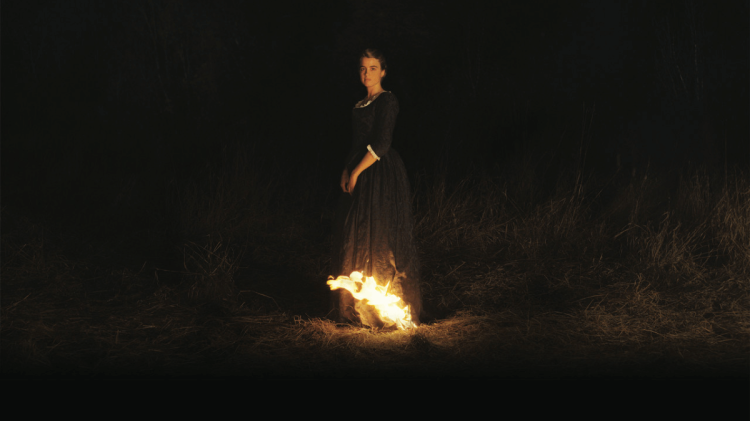VERDICT
A gorgeous meditation on the nature of love, Portrait of a Lady on Fire showcases the beauty, heartbreak, and power behind the intimacy we seek. Even more, it indulges in the energy and joy present in the love, of any form, between women. Céline Sciamma has crafted something truly special here. See it immediately.
REVIEW
If nothing else can be said of Portrait of a Lady on Fire, it is a movie that is deeply in love with love.
Even when it’s a bad idea. Or troubled. Or doomed.
What makes Portrait so interesting is that it isn’t novel, at least in its base concept. A story of forbidden love is of course a well-trod path. Even more specifically, an artist (Noémie Merlant) falling in love with their subject (Adèle Haenel)? It’s at least a trope, if not a genre unto itself.
Yet it manages to take that maybe-genre, and invest it with a level of empathy and adoration that I’ve never seen.
Compare it to Shakespeare in Love, for example. Much of the drama there is the salaciousness of the relationship – the audience relationship is almost voyeuristic. You invest because you know that Gwyneth Paltrow and Joseph Fiennes cannot, should not, be together.
Portrait takes a different route. There is so much left unsaid about the conditions and relationship of the leads to the world that it’s not clear what their relationship would be viewed as. It might be forbidden because one is the artist, one is the subject. It could also be class based – one an artist with a single outfit, the other a rich family’s daughter.
But none of that is every brought to the fore. You can infer what you like, but the film doesn’t particularly care. Because the focus isn’t on you watching their relationship, it’s understanding it. It places you within the women’s heads. If they don’t feel it, you don’t feel it.
This disregard for anything beyond the characters’ own emotional journey extends to what would be the most obvious source of tension in the American version of this – both of the lovers are women. That is never once posed as a problem.
There is never a moment where a character has a tight close up and proudly declares their queerness. The tension that comes from the daughter’s destined marriage is not because it is to man – it’s just that it interrupts the wildfire romance that has sparked between her and the artist.
Perhaps the best way to describe this movie’s philosophy then is that the love women have for each other is a beautiful thing. Love, that can be a complicated, dangerous, heartbreaking thing. But the act of love between women, be it romantic, sexual, familial, or communal, is a beautiful thing.
This is expressed obviously between the romantic love shared by the leads. But it’s also explored in their relationship to their maid (Luána Bajrami), and the women of their local community. The relationship to the former is sisterly, caretaking. To the latter, the leads bask in both maternal wisdom and communal talent. Even in moments of severe pain, the leads are ask to witness, to take part.
It is shared struggle and achievement. Pain and reward.
Love.
This is the true beauty of the movie – it is an entire life’s worth of love in eleven days. Now this could be seen as moving too fast, perhaps not giving enough time to any particular emotional beat. But that is precisely the point.
There is never enough time. You meet someone who is unseen by others who have tried. But you can see them. Even when others have failed. And soon enough this becomes a feeling of necessity – not only can you see them but you must see them, for who they really are. Because you can, and others cannot.
You fall in love, maybe despite yourself. You show them beautiful things – maybe it’s music, art, writing. You call each other out, tearing down the facade of mystery you continue to work so hard to prove to the other.
Maybe this reaches a fever pitch, where you feel as though you are on fire – a metaphor this film takes no liberties with.
Yet even without an impending marriage to another person, or a domineering mother acting as an obstacle, or social convention, or any other possible issue – for you, dear reader, your love will come to an end. Because they end, sometimes for good reasons, and sometimes not. But it will come to an end.
Hopefully that’s because you’d had a long life with the person you love. And it is their time to move on to a place you cannot follow.
Regardless of if you’ve spent a lifetime with them, or only eleven days, it will never feel like you had enough time.
And you’ll be left with memory.
That is where the love begins in this movie – in the attempts to hold a person, the every-minute-detail that makes a person, in one’s memory.
And that’s where it ends.
In the memory of love.
“You’ve made me look so sad.”
“You were.”
“I’m not anymore.”
SYNOPSIS
France, 1760. Marianne is commissioned to paint the wedding portrait of Héloïse, a young woman who has just left the convent. Because she is a reluctant bride-to-be, Marianne arrives under the guise of companionship, observing Héloïse by day and secretly painting her by firelight at night. As the two women orbit one another, intimacy and attraction grow as they share Héloïse’s first moments of freedom. Héloïse’s portrait soon becomes a collaborative act of and testament to their love.
Rotten Tomatoes
